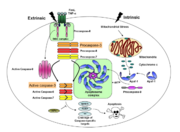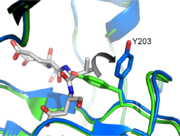Caspase-3 Regulatory Mechanisms
From Proteopedia
IntroductionCaspases are cysteine-aspartic acid proteases and are key protein facilitators for the faithful execution of apoptosis or programmed cell death. Dysregulation in the apoptotic pathway has been implicated in a variety of diseases such as neurodegeneration, cancer, heart disease and some metabolic disorders. Because of the crucial role of caspases in the the apoptotic pathway, abnormalities in their functions would cause haywire in the apoptotic cascade and can be deleterious to the cell. Caspases are thus being considered as therapeutic targets in apoptosis-related diseases. Any apoptotic signal received by the cell causes the activation of initiator caspases (-8 and -9) by associating with other protein platforms to form a functional holoenzyme. These initiator caspases then cleave the executioner caspases -3, -6, and -7. Caspase-3 specifically functions to cleave downstream apoptotic targets as well as both caspase-6 and -7, which in turn cleave their respective targets to induce cell death. Aside from being able to activate caspase-6 and -7, caspase-3 also regulates caspase-9 activity, operating via a feedback loop. This dual action of caspase-3 confers its distinct regulatory mechanisms, resulting in a wider extent of its effects in the apoptotic cascade. Overview of Caspase-3 StructureDimer FormationCaspase-3 shares many structural characteristics with other caspases. It is synthesized in the cell in its zymogen form, consisting of an N-terminal prodomain followed by a large and small subunit linked to each other by an intersubunit linker. Like other executioner caspases, caspase-3 has a short N-terminal prodomain the function of which remains unknown. Maturation of the enzyme involves at least two cleavage events- one to remove the N-terminal prodomain and the other to cleave the intersubunit linker. These two cleavage events have been shown to occur in a sequential fashion, with the cleavage between the small (p12) and large (p17) subunits preceding the pro domain removal. The high specificity of caspases directs the cleavage of the intersubunit linker at specific aspartate residues and generates the mature form of the enzyme. Caspase-3 in its functional form is a ; each heterodimer is formed and stabilized by hydrophobic interactions between the large and small subunit. ß-sheets from each heterodimer then interact resulting in a 12-stranded , around which α-helices are positioned. The active pocket of caspase-3 is defined by . Binding of a , such as DEVD-CHO to the active site of the enzyme induces a conformational change that allows the L2 and L2' loops to interlock and stabilize the active site . Like caspase-7, caspase-3 recognizes a Asp-X-X-Asp sequence as a cleavage site in its protein substrates. Caspase-3 Loop Bundle and Active Site
| |||||||||||||||||||||||||
References
Bose, K., C. Pop, et al. (2003). "An uncleavable procaspase-3 mutant has a lower catalytic efficiency but an active site similar to that of mature caspase-3." Biochemistry 42(42): 12298-12310.
Boucher, D., V. Blais, et al. (2012). "Caspase-7 uses an exosite to promote poly(ADP ribose) polymerase 1 proteolysis." Proc Natl Acad Sci U S A 109(15): 5669-5674.
Hardy, J. A., J. Lam, et al. (2004). "Discovery of an allosteric site in the caspases." Proc Natl Acad Sci U S A 101(34): 12461-12466.
Proteopedia Page Contributors and Editors (what is this?)
Scott Eron, Banyuhay P. Serrano, Alexander Berchansky, Yunlong Zhao, Jaime Prilusky, Michal Harel


